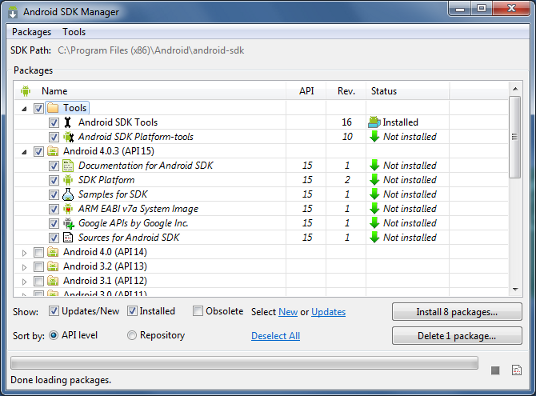By default, the Android SDK does not include everything you need to start developing. The SDK separates tools, platforms, and other components into packages you can download as needed using the Android SDK Manager . So before you can start, there are a few packages you should add to your Android SDK.
To start adding packages, launch the Android SDK Manager in one of the following ways:
-
In Eclipse or Android Studio, click
SDK Manager
 in the toolbar.
in the toolbar.
-
If you're not using Eclipse or Android Studio:
-
Windows: Double-click the
SDK Manager.exefile at the root of the Android SDK directory. -
Mac/Linux: Open a terminal and navigate to the
tools/directory in the Android SDK, then executeandroid sdk.
-
Windows: Double-click the
When you open the SDK Manager for the first time, several packages will be selected by default. Leave these selected, but be sure you have everything you need to get started by following these steps:
-
Get the latest SDK tools

As a minimum when setting up the Android SDK, you should download the latest tools and Android platform:
-
Open the Tools directory and select:
- Android SDK Tools
- Android SDK Platform-tools
- Android SDK Build-tools (highest version)
-
Open the first Android X.X folder (the latest version) and select:
- SDK Platform
-
A system image for the emulator, such as
ARM EABI v7a System Image
-
Open the Tools directory and select:
-
Get the support library for additional APIs
The support library is required for:
It also provides these popular APIs:
The Android Support Library provides an extended set of APIs that are compatible with most versions of Android.
Open the Extras directory and select:
- Android Support Repository
- Android Support Library
-
Get Google Play services for even more APIs
The Google Play services APIs provide a variety of features and services for your Android apps, such as:
To develop with Google APIs, you need the Google Play services package:
Open the Extras directory and select:
- Google Repository
- Google Play services
Note: Google Play services APIs are not available on all Android-powered devices, but are available on all devices with Google Play Store. To use these APIs in the Android emulator, you must also install the the Google APIs system image from the latest Android X.X directory in the SDK Manager.
-
Install the packages
Once you've selected all the desired packages, continue to install:
- Click Install X packages .
- In the next window, double-click each package name on the left to accept the license agreement for each.
- Click Install .
The download progress is shown at the bottom of the SDK Manager window. Do not exit the SDK Manager or it will cancel the download.
-
Build something!
With the above packages now in your Android SDK, you're ready to build apps for Android. As new tools and other APIs become available, simply launch the SDK Manager to download the new packages for your SDK.
Here are a few options for how you should proceed:
Get started
If you're new to Android development, learn the basics of Android apps by following the guide to Building Your First App .
Build for wearables
If you're ready to start building apps for Android wearables, see the guide to Building Apps for Android Wear .
Use Google APIs
To start using Google APIs, such as Maps or Play Game services, see the guide to Setting Up Google Play Services .